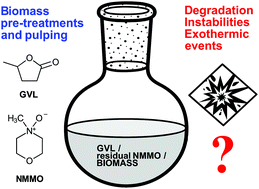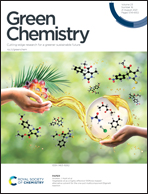On the chemical interactions of the biomass processing agents γ-valerolactone (GVL) and N-methylmorpholine-N-oxide (NMMO)†
Abstract
In new biorefinery processes, NMMO/water is used for the pre-treatment of biomass to increase the efficiency of subsequent digestion processes, while GVL/water is used for “organosolv” fractionation of biomass. The combination of both methods, GVL digestion after pre-activation by NMMO, appears to be reasonable, but has not been successful. In the present study, we examine the reason for this failure and investigate the chemical processes in the ternary system NMMO/GVL/water and in the quaternary system NMMO/GVL/water/“biomass”. The consumption kinetics of NMMO and GVL at different temperatures, water contents and NMMO/GVL ratios were recorded. The respective degradation and reaction products were identified for the first time, by combining nuclear magnetic resonance (NMR) spectroscopy, and gas chromatography – mass spectrometry (GC-MS) techniques and synthesis of authentic compounds for comparison. Decomposition products of NMMO and GVL on their own as well as reaction products of both components together (α-morpholinomethyl-GVL (7), α-methylene-GVL (8), and 4-hydroxyvaleric acid morpholide (13)) were observed among the main degradation products. At temperatures of 150 °C and at a water content <10% (or 180 °C and 30%, respectively), the contained NMMO was autocatalytically decomposed in highly exothermic reactions, and explosive processes occurred which caused complete charring of the reaction mixture. At higher water contents, the system remained stable, but NMMO was still completely degraded and GVL was consumed to a significant extent. While the biomass component cellulose was largely unreactive, lignin was the main culprit that caused degradation reactions in the system. The formation of NMM (5) from NMMO and the resulting ring opening of GVL to 4-hydroxyvaleric acid (3), which is immediately oxidized by NMMO to levulinic acid (4), were the initial reactions that triggered the subsequent, more complex decomposition pathways. The chemical structures of all degradation products were fully analytically confirmed. Due to the instability of the NMMO/GVL system, the combination of NMMO biomass pre-treatment and GVL biomass digestion is prohibited, unless a careful removal of NMMO is carried out beforehand. Besides these practical conclusions with regard to biomass processing in biorefineries, the present study provides hopefully helpful insights into the chemistry of NMMO and GVL and the underlying reaction mechanisms.



 Please wait while we load your content...
Please wait while we load your content...